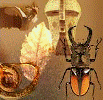Museum, University of Nebraska State
Date of this Version
2020
Citation
Natural History Magazine, September 2004, Volume 113, Number 7, Pages 56-57
Abstract
Twelve million years ago a volcanic super-eruption in what is now southwestern Idaho created an enormous ashfall that blanketed the Great Plains with several inches of volcanic ash, devastating the local wildlife. Evidence of this geologic event lies within the hills of the Niobrara River Valley in northeast Nebraska, at a place aptly named the Ashfall Fossil Beds State Historical Park. Located near the tiny village of Royal, the Ashfall Park has been developed around a waterhole where animals succumbed after breathing in the volcanic dust. Buried deeply by windblown volcanic ash in the weeks following the eruption, the skeletons of barrel-bodied rhinos, three-toed horses, camels, and saber-toothed deer were preserved in exquisite detail. Discovered by a paleontologist during a day of routine field work in 1971, subsequent excavations revealed a fossil site of international significance. Hundreds of complete, intact skeletons of Miocene mammals, birds and turtles were unearthed. In 1991 the site opened as a state park. Visitors can still see ongoing excavation in the Hubbard Rhino Barn, built to protect the still unexcavated portion of the ancient waterhole, and the fossils found there, left in-situ for public viewing. The Ashfall site is an educational facility of significance for those interested in the science of paleontology, the ancient history of the Great Plains, and even the possible consequences of a future Yellowstone hotspot eruption.
Included in
Evolution Commons, Paleontology Commons, Volcanology Commons



Comments
This article was originally published in the "This Land" section of Natural History Magazine.